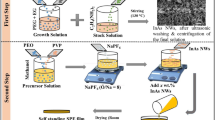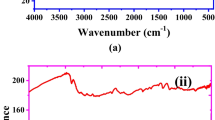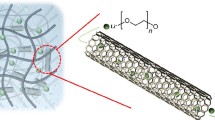Abstract
The intrinsic drawbacks of electrolytes and the growth of lithium dendrites limit the development of commercial lithium batteries. To address the aforementioned challenges, a novel biomimetic brain-like nanostructure (BBLN) solid polymer electrolyte was created by manipulating the shape of the incorporated nanoparticles. Our designed BBLN solid polymer electrolyte was created by incorporating spherical core-shell (UIO-66@67) fillers into polymer electrolyte, which is significantly different from traditional polymer-based composite electrolytes. UIO-66@67 spherical nanoparticles are highly favorable to eliminating polymer electrolyte stress and deformation during solidification, indicating a great potential for fabricating highly uniform BBLN solid polymer electrolytes with a substantial number of continuous convolutions. Furthermore, spherical nanoparticles can significantly reduce the crystalline structure of polymer electrolytes, improving polymer chain segmental movement and providing continuous pathways for rapid ion transfer. As a result, BBLN solid polymer electrolyte shows excellent ionic conductivity (9.2 × 10−4 S cm−1), a high lithium transference number (0.74), and outstanding cycle stability against lithium electrodes over 6500 h at room temperature. The concept of biomimetic brain-like nanostructures in this work demonstrates a novel strategy to enhance ion transport in polymer-based electrolytes for solid-state batteries.
摘要
电解液的固有缺陷以及锂枝晶问题严重限制了当前商业化锂离子电池的发展. 为了解决上述问题, 本文通过控制加入纳米填料的形状, 获得了具有仿生脑状纳米结构的固态聚合物电解质(BBLN). 与传统复合聚合物固态电解质不同, 我们通过添加球状核壳UIO-66@67纳米填料制备了具有仿生脑状纳米结构的固态聚合物电解质. 球状UIO-66@67纳米颗粒能够有效减小聚合物基质在固化过程中的形变, 从而促进形成独特的仿生脑状纳米结构. 此外, 球状纳米颗粒能够有效降低聚合物电解质的结晶度, 提高其链段运动能力, 形成连续的锂离子传输路径. 基于此, 仿生脑状固态聚合物电解质具有高离子电导率(9.2 × 10−4 S cm−1), 高锂离子迁移数(0.74)和良好的锂金属兼容性(>6500 h). 本研究中提出的仿生脑状纳米结构的设计理念是一种有效增强固态电池中聚合物基电解质的离子输运的新策略.
Similar content being viewed by others
References
Chheda JN, Huber GW, Dumesic JA. Liquid-phase catalytic processing of biomass-derived oxygenated hydrocarbons to fuels and chemicals. Angew Chem Int Ed, 2007, 46: 7164–7183
Yu D, Wu B, Ge L, et al. Decorating nanoporous ZIF-67-derived NiCo2O4 shells on a Co3O4 nanowire array core for battery-type electrodes with enhanced energy storage performance. J Mater Chem A, 2016, 4: 10878–10884
Guan BY, Yu L, Wang X, et al. Formation of onion-like NiCo2S4 particles via sequential ion-exchange for hybrid supercapacitors. Adv Mater, 2017, 29: 1605051
Li S, Zhang SQ, Shen L, et al. Progress and perspective of ceramic/polymer composite solid electrolytes for lithium batteries. Adv Sci, 2020, 7: 1903088
Sun J, Yao X, Li Y, et al. Facilitating interfacial stability via bilayer heterostructure solid electrolyte toward high-energy, safe and adaptable lithium batteries. Adv Energy Mater, 2020, 10: 2000709
Zhang D, Xu X, Qin Y, et al. Recent progress in organic-inorganic composite solid electrolytes for all-solid-state lithium batteries. Chem Eur J, 2020, 26: 1720–1736
Zhang J, Li L, Zheng C, et al. Silicon-doped argyrodite solid electrolyte Li6PS5I with improved ionic conductivity and interfacial compatibility for high-performance all-solid-state lithium batteries. ACS Appl Mater Interfaces, 2020, 12: 41538–41545
Yu S, Schmohl S, Liu Z, et al. Insights into a layered hybrid solid electrolyte and its application in long lifespan high-voltage all-solidstate lithium batteries. J Mater Chem A, 2019, 7: 3882–3894
Zhang X, Wang S, Xue C, et al. Self-suppression of lithium dendrite in all-solid-state lithium metal batteries with poly(vinylidene difluoride)-based solid electrolytes. Adv Mater, 2019, 31: 1806082
Gao Z, Sun H, Fu L, et al. Promises, challenges, and recent progress of inorganic solid-state electrolytes for all-solid-state lithium batteries. Adv Mater, 2018, 30: 1705702
Zhang Z, Shao Y, Lotsch B, et al. New horizons for inorganic solid state ion conductors. Energy Environ Sci, 2018, 11: 1945–1976
Bachman JC, Muy S, Grimaud A, et al. Inorganic solid-state electrolytes for lithium batteries: mechanisms and properties governing ion conduction. Chem Rev, 2016, 116: 140–162
Janek J, Zeier WG. A solid future for battery development. Nat Energy, 2016, 1: 1–4
Dirican M, Yan C, Zhu P, et al. Composite solid electrolytes for all-solid-state lithium batteries. Mater Sci Eng-R-Rep, 2019, 136: 27–46
Zhou X, Jiang H, Zheng H, et al. Nonflammable hybrid solid electrolyte membrane for a solid-state lithium battery compatible with conventional porous electrodes. J Membrane Sci, 2020, 603: 117820
Homann G, Stolz L, Winter M, et al. Elimination of “Voltage noise” of poly (ethylene oxide)-based solid electrolytes in high-voltage lithium batteries: linear versus network polymers. iScience, 2020, 23: 101225
Zheng F, Kotobuki M, Song S, et al. Review on solid electrolytes for all-solid-state lithium-ion batteries. J Power Sources, 2018, 389: 198–213
Zhang Q, Liu K, Ding F, et al. Recent advances in solid polymer electrolytes for lithium batteries. Nano Res, 2017, 10: 4139–4174
Zhou D, He YB, Liu R, et al. In situ synthesis of a hierarchical all-solidstate electrolyte based on nitrile materials for high-performance lithium-ion batteries. Adv Energy Mater, 2015, 5: 1500353
Xu L, Tang S, Cheng Y, et al. Interfaces in solid-state lithium batteries. Joule, 2018, 2: 1991–2015
Lv F, Wang Z, Shi L, et al. Challenges and development of composite solid-state electrolytes for high-performance lithium ion batteries. J Power Sources, 2019, 441: 227175
Xue Z, He D, Xie X. Poly(ethylene oxide)-based electrolytes for lithiumion batteries. J Mater Chem A, 2015, 3: 19218–19253
Zhao R, Liang Z, Zou R, et al. Metal-organic frameworks for batteries. Joule, 2018, 2: 2235–2259
Chen N, Li Y, Dai Y, et al. A Li+ conductive metal organic framework electrolyte boosts the high-temperature performance of dendrite-free lithium batteries. J Mater Chem A, 2019, 7: 9530–9536
Abdelmaoula AE, Shu J, Cheng Y, et al. Core-shell MOF-in-MOF nanopore bifunctional host of electrolyte for high-performance solidstate lithium batteries. Small Methods, 2021, 5: 2100508
Wang Z, Wang Z, Yang L, et al. Boosting interfacial Li+ transport with a MOF-based ionic conductor for solid-state batteries. Nano Energy, 2018, 49: 580–587
Wu JF, Guo X. Nanostructured metal-organic framework (MOF)-de-rived solid electrolytes realizing fast lithium ion transportation kinetics in solid-state batteries. Small, 2019, 15: 1804413
Adrian PN, Andreas O, Dan C. Numerical analysis of the diffusive mass transport in brain tissues with applications to optical sensors. Proc of SPIE, 2013, 8576: 857605
Silbernagel S, Despopoulos A. Taschenatlas Physiologie. New York: Thieme Stuttgart, 2012
Jiang J, Guo J, Wan X, et al. 2D MoS2 neuromorphic devices for brainlike computational systems. Small, 2017, 13: 1700933
Nicholson C. Diffusion and related transport mechanisms in brain tissue. Rep Prog Phys, 2001, 64: 815–884
Tauseefur R, Eldad H, Kilian MP, et al. Multimodal registration of white matter brain data via optimal mass transport. Midas J, 2008, 27–35
Gallos LK, Makse HA, Sigman M. A small world of weak ties provides optimal global integration of self-similar modules in functional brain networks. Proc Natl Acad Sci USA, 2012, 109: 2825–2830
Ma M, Wang X, Duan Y, et al. Optimal mass transport based brain morphometry for patients with congenital hand deformities. Vis Comput, 2019, 35: 1311–1325
Chen Y, Wang Q, Wang T. Facile large-scale synthesis of brain-like mesoporous silica nanocomposites via a selective etching process. Nanoscale, 2015, 7: 16442–16450
Ray LA, Heys JJ. Fluid flow and mass transport in brain tissue. Fluids, 2019, 4: 196
Agaliotis EM, Rosenberger MR, Ares AE, et al. Influence of the shape of the particles in the solidification ofcomposite materials. Procedia Mater Sci, 2012, 1: 58–63
Zhu Y, Li J, Wan M, et al. A new route for the preparation of brain-like nanostructured polyaniline. Macromol Rapid Commun, 2007, 28: 1339–1344
Seo S-, Park D, Park S, et al. “Brain-coral-like” mesoporous hollow CoS2@N-doped graphitic carbon nanoshells as efficient sulfur reservoirs for lithium-sulfur batteries. Adv Funct Mater, 2019, 29: 1903712
Zhou JJ, Wang R, Liu XL, et al. In situ growth of CDS nanoparticles on Uio-66 metal-organic framework octahedrons for enhanced photocatalytic hydrogen production under visible light irradiation. Appl Surf Sci, 2015, 346: 278–283
Øien-Ødegaard S, Bouchevreau B, Hylland K, et al. UiO-67-type metal-organic frameworks with enhanced water stability and methane adsorption capacity. Inorg Chem, 2016, 55: 1986–1991
Largeot C, Portet C, Chmiola J, et al. Relation between the ion size and pore size for an electric double-layer capacitor. J Am Chem Soc, 2008, 130: 2730–2731
Wang Z, Wang S, Wang A, et al. Covalently linked metal-organic framework (MOF)-polymer all-solid-state electrolyte membranes for room temperature high performance lithium batteries. J Mater Chem A, 2018, 6: 17227–17234
Porcarelli L, Gerbaldi C, Bella F, et al. Super soft all-ethylene oxide polymer electrolyte for safe all-solid lithium batteries. Sci Rep, 2016, 6: 19892
Schulze MW, McIntosh LD, Hillmyer MA, et al. High-modulus, high-conductivity nanostructured polymer electrolyte membranes via polymerization-induced phase separation. Nano Lett, 2014, 14: 122–126
Chopade SA, Au JG, Li Z, et al. Robust polymer electrolyte membranes with high ambient-temperature lithium-ion conductivity via polymerization-induced microphase separation. ACS Appl Mater Interfaces, 2017, 9: 14561–14565
Xia Y, Xu N, Du L, et al. Rational design of ion transport paths at the interface of metal-organic framework modified solid electrolyte. ACS Appl Mater Interfaces, 2020, 12: 22930–22938
Bouchet R, Maria S, Meziane R, et al. Single-ion BAB triblock copolymers as highly efficient electrolytes for lithium-metal batteries. Nat Mater, 2013, 12: 452–457
Li D, Wang J, Guo S, et al. Molecular-scale interface engineering of metal-organic frameworks toward ion transport enables high-performance solid lithium metal battery. Adv Funct Mater, 2020, 30: 2003945
Wang G, He P, Fan LZ. Asymmetric polymer electrolyte constructed by metal-organic framework for solid-state, dendrite-free lithium metal battery. Adv Funct Mater, 2020, 31: 2007198
Zhou D, Liu R, Zhang J, et al. In situ synthesis of hierarchical poly(ionic liquid)-based solid electrolytes for high-safety lithium-ion and sodium-ion batteries. Nano Energy, 2017, 33: 45–54
Liang YF, Xia Y, Zhang SZ, et al. A preeminent gel blending polymer electrolyte of poly(vinylidene fluoride-hexafluoropropylene)-poly(pro-pylene carbonate) for solid-state lithium ion batteries. Electrochim Acta, 2019, 296: 1064–1069
Huang S, Cui Z, Qiao L, et al. An in-situ polymerized solid polymer electrolyte enables excellent interfacial compatibility in lithium batteries. Electrochim Acta, 2019, 299: 820–827
Gong Y, Fu K, Xu S, et al. Lithium-ion conductive ceramic textile: a new architecture for flexible solid-state lithium metal batteries. Mater Today, 2018, 21: 594–601
Wan Z, Lei D, Yang W, et al. Low resistance-integrated all-solid-state battery achieved by Li7La3Zr2O12 nanowire upgrading polyethylene oxide (PEO) composite electrolyte and PEO cathode binder. Adv Funct Mater, 2019, 29: 1805301
Liu L, Chu L, Jiang B, et al. Li1.4Al0.4Ti1.6(PO4)3 nanoparticle-reinforced solid polymer electrolytes for all-solid-state lithium batteries. Solid State Ion, 2019, 331: 89–95
Huo H, Chen Y, Luo J, et al. Rational design of hierarchical “ceramic-in-polymer” and “polymer-in-ceramic” electrolytes for dendrite-free solid-state batteries Adv Energy Mater, 2019, 9: 1804004
Huo H, Sun J, chen C, et al. Flexible interfaces between Si anodes and composite electrolytes consisting of poly(propylene carbonates) and garnets for solid-state batteries J Power Sources, 2018, 383: 150–156
Acknowledgements
This work was supported by the National Natural Science Foundation of China (51802239 and 52127816), the National Key Research and Development Program of China (2020YFA0715000), the Key Research and Development Program of Hubei Province (2021BAA070), Foshan Xianhu Laboratory of the Advanced Energy Science and Technology Guangdong Laboratory (XHT2020-005), and the Fundamental Research Funds for the Central Universities (2020III011GX, 2020IVB057, 2019IVB054 and 2019III062JL).
Author information
Authors and Affiliations
Contributions
Author contributions Abdelmaoula AE performed all the experiments and the data analyses as well as wrote the manuscript; Xu L and Mai L were in charge of this scientific research project, and the leaders of actual coordination of contributions; Abdelmaoula AE, Cheng Y, Mahdy AA, Tahir M and Liu Z contributed to the theoretical analysis All authors contributed to the general discussion
Corresponding authors
Ethics declarations
Conflict of interest The authors declare no conflict of interest.
Additional information
Supplementary information Supporting data are available in the online version of the paper.
Ahmed Eissa Abdelmaoula is currently pursuing his PhD degree at the School of Material Science and Engineering, Wuhan University of Technology (WUT). His research interests include the design and fabrication of solid electrolyte materials for energy storage.
Lin Xu is a professor of materials science and engineering at the School of Materials Science and Engineering, WUT. He received his PhD degree from WUT in 2013 and worked as a postdoctoral fellow at Harvard University in 2013–2016. His research focuses on the electrochemical energy storage.
Liqiang Mai is a Chair Professor of materials science and engineering at WUT, Dean of the School of Materials Science and Engineering, WUT, Fellow of the Royal Society of Chemistry. He received his PhD from WUT in 2004 and carried out his postdoctoral research at Georgia Institute of Technology in 2006–2007. He worked as an advanced research scholar at Harvard University in 2008–2011 and the University of California, Berkeley in 2017. His current research interests focus on new nanomaterials for electrochemical energy storage and micro/nano energy devices.
Rights and permissions
About this article
Cite this article
Abdelmaoula, A.E., Du, L., Xu, L. et al. Biomimetic brain-like nanostructures for solid polymer electrolytes with fast ion transport. Sci. China Mater. 65, 1476–1484 (2022). https://doi.org/10.1007/s40843-021-1940-2
Received:
Accepted:
Published:
Issue Date:
DOI: https://doi.org/10.1007/s40843-021-1940-2




